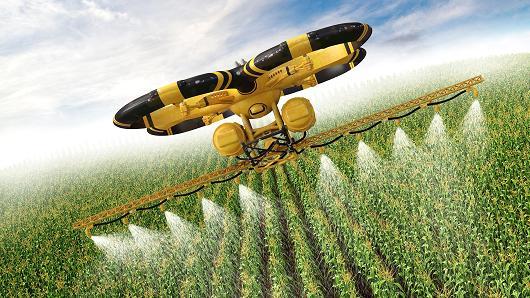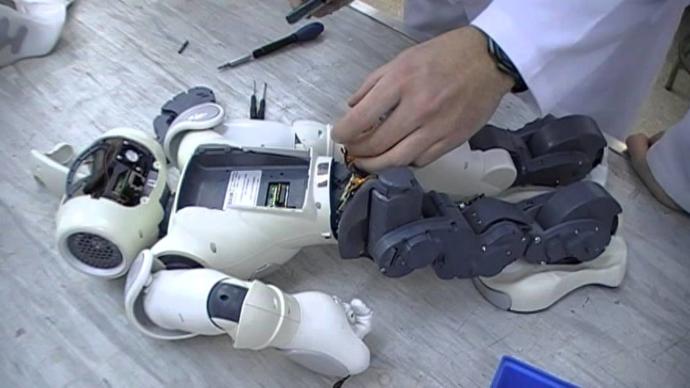One of the first rules of economics is that there's no such thing as a free lunch. Every product requires some kind of a cost to someone in some form.
Yet with the proper technological innovations, I want to propose the idea that there can be something very close to a free lunch, or at least as close to a free lunch as we can possibly achieve (perhaps ignoring some very hidden/implicit opportunity costs).

There are some key criteria that I see as essential towards achieving a mostly free lunch:
1) Autonomous
2) Self-replicating
3) Self-maintaining
These are not easy qualities to achieve but a system that can achieve all effectively reinforces itself in a way that can provide truly free labor, at least without imposing explicit costs to any human beings.
Agriculture
As an example, imagine the concept of autonomous agricultural droids. They are perfectly capable of sowing, fertilizing, irrigating, harvesting, rotating, inspecting, and storing crops all on their own. They can also react to natural disasters, pests, etc. Basically they perform all the roles of human farmers, only tirelessly and without error while operating solely on solar energy.
Further, let's say we have an economic system in place where this land reserved for agriculture has no recurring cost (exempt from land value/property taxes, i.e.).
We're already very close to free food at this point. Of course the food might still need to be rationed since there will be a limited supply, but such tireless droids might be able to output more than enough food to feed a very large populace. Everyone could have their share.

Yet there are still costs involved in spite of all of these assumptions. Engineering the droids might initially require designers and engineers. Manufacturing the droids might require manufacturers as well as a variety of materials harvested using human labor.
Excluding the one-time costs of designing, engineering, and manufacturing these droids, we might also have recurring costs. Technicians might be required to monitor and maintain the droids.
Some droids might wear down or break down. Parts might need to be obtained elsewhere for repair and maintenance. Some droids may become damaged and need to be replaced.
Self-Replicating
We still have the pesky recurring cost of human labor in the above scenario in the form of technicians, manufacturers, and those harvesting the materials required to build and repair these droids.
Yet if a droid can perform all of the above jobs as well, we've now eliminated all explicit human costs. If a droid can procure the materials necessary to build a clone of itself autonomously and replicate itself, then we have a self-contained, self-sustaining system that outputs food at no human cost.
With the ability to self-replicate, a damaged droid beyond repair could be harvested and used by a functioning droid to replicate a functional version of itself.
Self-replication is a wildly ambitious idea, but we already have 3D printers capable of replicating themselves (though not autonomously, without the capability of procuring the material, and still requiring further assembly from a human being).

The most difficult part to automate is the procuring of materials required for self-replication. The materials might be scattered across the world.
A first step might be to provide a garage with plenty of spare parts, already manufactured, required for replication. The droids could visit that garage when parts for repairs or a new replica is required. This still incurs recurring costs but relatively cheap ones that don't require highly-skilled labor.
A second step might be to replace the spare parts with simply raw material. If the droids can then build the parts themselves from raw material, the costs become considerably cheaper yet.
The final step would be to expand the system to the point where droids are able to harvest the raw material required for replication and repair themselves.
Self-Maintenance
It should follow that a droid capable of autonomous self-replication should likewise be able to maintain/repair itself and replace completely-malfunctioning clones of itself. It shouldn't require much more, if anything, provided it can manage self-replication.
It's worth noting that the same model of droid should be able to repair clones of itself. If a different model of repair droids is required for maintenance and replication, we end up shifting the costs of maintenance of the repair-model droids to humans maintaining them. To eliminate human costs outright, the system has to be entirely enclosed and self-sustaining. We have to take the human out of the picture entirely.

Once the human is entirely eliminated from the picture, all we end up with is a periodic stockpile of food that cost absolutely nothing to output as far as explicit costs to human beings go.
Conclusion
Anyway, I just wanted to throw out this crazy idea. I'm not suggesting that we'll see technology of this sort any time soon. I just wanted to lay out the fundamental conditions necessary to provide something as close as possible to a free lunch.

 Holidays
Holidays  Girl's Behavior
Girl's Behavior  Guy's Behavior
Guy's Behavior  Flirting
Flirting  Dating
Dating  Relationships
Relationships  Fashion & Beauty
Fashion & Beauty  Health & Fitness
Health & Fitness  Marriage & Weddings
Marriage & Weddings  Shopping & Gifts
Shopping & Gifts  Technology & Internet
Technology & Internet  Break Up & Divorce
Break Up & Divorce  Education & Career
Education & Career  Entertainment & Arts
Entertainment & Arts  Family & Friends
Family & Friends  Food & Beverage
Food & Beverage  Hobbies & Leisure
Hobbies & Leisure  Other
Other  Religion & Spirituality
Religion & Spirituality  Society & Politics
Society & Politics  Sports
Sports  Travel
Travel  Trending & News
Trending & News
Most Helpful Opinions